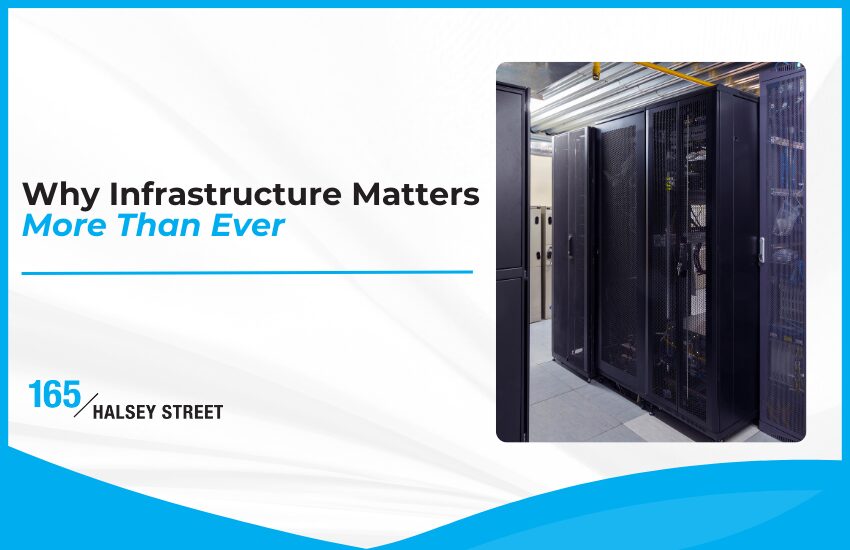Every second, an immense volume of data moves across networks, powering everything from high-frequency trading on Wall Street to real-time video conferencing for remote teams. Behind the scenes, a complex data infrastructure of fiber networks, data centers and interconnection hubs enables this seamless exchange of data.
However, as businesses become more data-dependent and technologies like AI, IoT and cloud computing push bandwidth demands even higher, the importance of a robust, scalable data infrastructure has never been greater.
The Evolution of Data Infrastructure and the Need for Optimization
For decades, organizations primarily relied on centralized IT systems, moving data within on-premises environments. However, as cloud adoption surged and digital transformation took hold, businesses began shifting toward distributed IT architectures, requiring high-speed, low-latency connectivity across multiple locations.
Today, businesses don’t just store data—they move, analyze and act on it in real time. AI models require massive datasets to train and operate efficiently. Enterprises rely on hybrid cloud environments to balance performance and cost-effectiveness. Financial institutions execute millions of transactions per second, where even milliseconds of delay can mean lost revenue.
In all these scenarios, one thing remains constant: infrastructure is the foundation of an efficient data exchange strategy. Without it, even the most advanced software solutions and cloud platforms can experience bottlenecks, leading to poor performance, security vulnerabilities, and lost opportunities.
Why Physical Infrastructure Defines Digital Success
While software solutions optimize how data is processed and managed, physical data infrastructure dictates how efficiently that data moves. The key components of a high-performance data exchange ecosystem include:
1. High-Speed, Low-Latency Connectivity
Businesses dealing with large data transfers, cloud workloads and latency-sensitive applications need direct, high-speed fiber connections. Traditional public internet connections often introduce delays, making private, carrier-grade data infrastructure a must-have for organizations that demand real-time performance.
At 165 Halsey, our facility is designed to support high-capacity data exchange, offering direct access to a vast ecosystem of carriers, cloud providers and enterprises, all within a low-latency environment.
2. Redundant and Resilient Data Infrastructure
A single point of failure can cause widespread disruptions, making redundancy a critical aspect of any data infrastructure supporting high-volume data exchange. This includes:
- Diverse fiber routes to ensure uninterrupted connectivity.
- Redundant power systems to mitigate downtime risks.
- Disaster recovery capabilities for business continuity.
At 165 Halsey, our infrastructure is built for resilience, providing businesses with guaranteed uptime and reliability to support mission-critical applications.
3. Strategic Interconnection for Efficiency
The more direct connections a business has to key partners, carriers and cloud services, the faster and more cost-efficient their data exchange will be. This is why interconnection hubs—like carrier-neutral colocation facilities—are vital for optimizing performance.
- Cross-connections between networks eliminate unnecessary hops, reducing latency.
- Cloud on-ramps provide direct access to major cloud platforms, improving workload efficiency.
- Peering opportunities allow businesses to exchange data directly, lowering bandwidth costs.
By colocating at 165 Halsey, organizations benefit from direct access to hundreds of interconnection points, reducing network congestion and ensuring seamless data flow between digital ecosystems.
The Business Impact of Optimized Data Exchange
Investing in high-performance data infrastructure isn’t just about meeting current needs—it’s about staying ahead of future demands. Companies that prioritize fast, secure and reliable data exchange gain significant advantages, including:
- Improved User Experience – Faster data transfers result in lower latency for cloud applications, video streaming and SaaS solutions.
- Cost Savings – Direct interconnections and carrier-neutral colocation help reduce bandwidth expenses while improving efficiency.
- Stronger Security – Private network connectivity minimizes exposure to cyber threats, ensuring data integrity and compliance.
- Scalability – With scalable colocation options, businesses can seamlessly expand their IT footprint without overhauling their network infrastructure.
Why 165 Halsey is the Ultimate Data Exchange Hub
Located in Newark, New Jersey, 165 Halsey serves as a critical interconnection point for businesses looking to enhance their data exchange capabilities. As a carrier-neutral, high-performance colocation facility, we provide:
- Unparalleled connectivity to top-tier carriers, cloud providers and internet exchanges.
- Scalable colocation options to support business growth and evolving data needs.
- Enterprise-grade security and redundancy to ensure uninterrupted operations.
- Low-latency connectivity to key metro areas, including New York City and Philadelphia.
Future-Proofing Your Data Infrastructure Strategy with 165 Halsey
As data exchange demands continue to rise, businesses must be proactive in optimizing their data infrastructure. Whether handling cloud migrations, AI workloads or real-time transactions, having the right colocation and connectivity strategy in place will be the difference between operational efficiency and costly bottlenecks.
At 165 Halsey, we provide the data infrastructure, interconnection and expertise needed to ensure seamless, secure, and high-performance data exchange. Ready to elevate your connectivity strategy? Review an in-depth chart of our infrastructure and get in touch with our team today.

